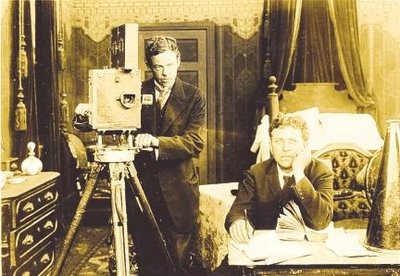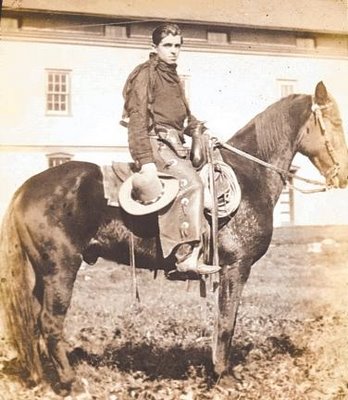Early movie studio on PBS

By Jan Feighner
AUDUBON — The Delaware Valley is riddled with obvious points of interest regarding the nation's Cradle of Freedom, but it also offers odd bits of history. Scattered throughout the suburbs, some of these little known places are almost forgotten.
The Betzwood Motion Picture Studio bordering Valley Forge Park near Audubon is such a place. Few people know that several stone buildings near the Betzwood Bridge are remnants of a once active silent movie studio.
The thriving business, now owned by O'Neill Properties, proponents of historic structure preservation, operated between 1912 and 1923. Its founder, Siegmund Lubin of Philadelphia, built numerous structures on 350 acres of land that included administrative offices, a boiler house, a processing plant, scenery storage buildings, an all-glass studio for day shots, two dark studios minus windows with electric lighting, film vaults, and a boathouse.
A turbine beneath the boathouse, turned by water entering a sluice, generated the studio's electricity. A 19th century stone mansion, razed decades ago, housed visiting celebrities and sometimes Lubin himself.
Several famous silent screen stars worked on the lot, as well as contract and stock players. Many lived on the immense estate that constantly bustled with life.
Directors shot multiple scripted and improvised movies at once. Sets shifted between buildings. Lights and cameras changed constantly for each scene. Costumers, make-up artists, production assistants, writers, prop masters, and an enormous crew made certain that everything went smoothly for Lubin's busy operation.
Then, nothing: only a few buildings stood time's test. Cast and crew passed away; sets, props, and costumes disappeared. Little evidence remained of what by today's standards could have been a city of its own.
What happened?
Tonight, "History Detectives" investigates the mystery of the Betzwood Studio. Airing on WHYY at 9 p.m., the popular PBS program features host Dr. Tukufu Zuberi, the University of Pennsylvania's Lasry Family Professor of Public Relations, professor and chairman of the Department of Sociology, and faculty associate director of the Center for Africana Studies, as he explores the latest Delaware Valley history mystery.

The adventure began in Florida when Billie Chapman-Rooney of St. Petersburg watched the weekly program which ends with a request from viewers to propose a mystery. She knew two photo albums she received from her father during the late 1980s were special, but never knew just how special.
Chapman-Rooney is related to the Lubin family in an odd way. Her mother's brother's mother-in-law, Lucia, was married to Herbert, Siegmund Lubin's nephew. She remembers Lucia from her childhood in the 1950s as a flamboyant woman who drove a Thunderbird convertible, smoked long filtered cigarettes, and wore rhinestone shoes. She never knew Herbert, and her father who passed away before she began her Betzwood quest.
"In 1973, the family homes in St. Petersburg were being moved (except for) the garages," Chapman-Rooney explained. "After one of my uncles got all he wanted, he told my dad that he could have whatever he wanted. He took, among other things, an old suitcase, which, when he looked inside, he found the Lubin photos and other Lubin personal items.
"My dad kept them for many years and as I got older and acquired a love for old things, he gave them to me. I researched several avenues about the albums but always came to a dead end."
"History Detectives" wasted no time contacting her about her request, desiring to film a segment onsite and in Zuberi's office. They contacted Joe Eckhardt, emeritus professor of history at Montgomery County Community College (MCCC), whose extensive Lubin knowledge and private collection led to MCCC's creation of the Betzwood Archive on campus, an annual Betzwood Film Festival with the original films, and a biography of Siegmund Lubin entitled "The King of the Movies."
The show's producers hoped Eckhardt could shed some light on the 100 or so 8 by 10-inch labeled photographs. Eckhardt detailed Lubin's and the studio's history, walked the crew around the former estate, and discussed his 30 years of Betzwood research, but he had never seen anything so marvelous as the albums.
"I had never seen anything like it. They are the most significant survival from the Betzwood Studio," Eckhardt said. "They are the single most remarkable documentation of what that studio was like and how it worked. They're extraordinarily well preserved."
Eckhardt stated that Herbert created the books, taking pictures and meticulously labeling each one. The younger Lubin was Siegmund's nephew, brought to America in 1914 at age 16 from Berlin. His famous uncle wanted presumably to remove him from the impending World War I that began only months later. Herbert lived at the studio with the intent of learning the business. Instead, he became one of the cowboy actors.
One of the books details the Betzwood Ranch where the crew filmed westerns and sports pictures of the mansion, manager's house, barns, cowboy actors, and horses. The other comprises photos of Siegmund, the board of directors, actors, actresses, film studio, chefs in the commissary, chauffeurs, typists, and film vault.
Eckhardt and Chapman-Rooney disagree about the albums' intent. Eckhardt maintains that Herbert used it to document the studio. Chapman-Rooney, however, describes the photos as professionally finished pictures, one on each page, used as a business piece like a portfolio.
Both Chapman-Rooney and Eckhardt appear in the episode. They remain curious as to the final product since each experienced repeated shots at different angles with the single camera used in filming. She introduces the segment with her question of what happened to her family's thriving studio, and he provides the answers.
So, who was this silent film pioneer Siegmund Lubin, who befriended Thomas Edison after a patent infringement lawsuit? And what happened to his successful Betzwood Motion Picture Studio?
Watch "History Detectives" Monday, July 13 at 9 p.m. on WHYY and see.
 RSS
RSS

1 Comments:
Thank you for the research and writing of this article! I was watching History Detectives last night from my home in Seattle, and as soon as I saw the visit to the MCCC archives, I immediately began to wonder exactly where this ranch was located, since I grew up in the area, and also have a great personal interest in film and film history. But the show didn't get more specific than saying in was in the Philly area.
An online search about the ranch turned up your article, which not only answered my question but which reported on many other details that I could find in no other place. I am sure this information will enhance my next trip back home. And all from my old local paper!
Thanks for doing Lansdale & the north penn area proud with such an interesting and well-written piece of journalism, and for making the information publicly available on your website.
Post a Comment
Subscribe to Post Comments [Atom]
<< Home